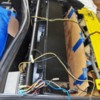I have two "meriah" fans on the front of my radiator. I pulled one of them out to diagnose why it isnt coming on when the other does, and I found an arrow on the fan that points CCW when looking at it from the front. This means its pulling air from the (rear of car to front of car) which is dead wrong....right!? The one that works indeed spins that way so i reversed the wires. Just wanted to make sure that Im not crazy...the person that installed the fans is crazy. Someone please confirm this seemingly stupid question.
Thanks!
Original Post


